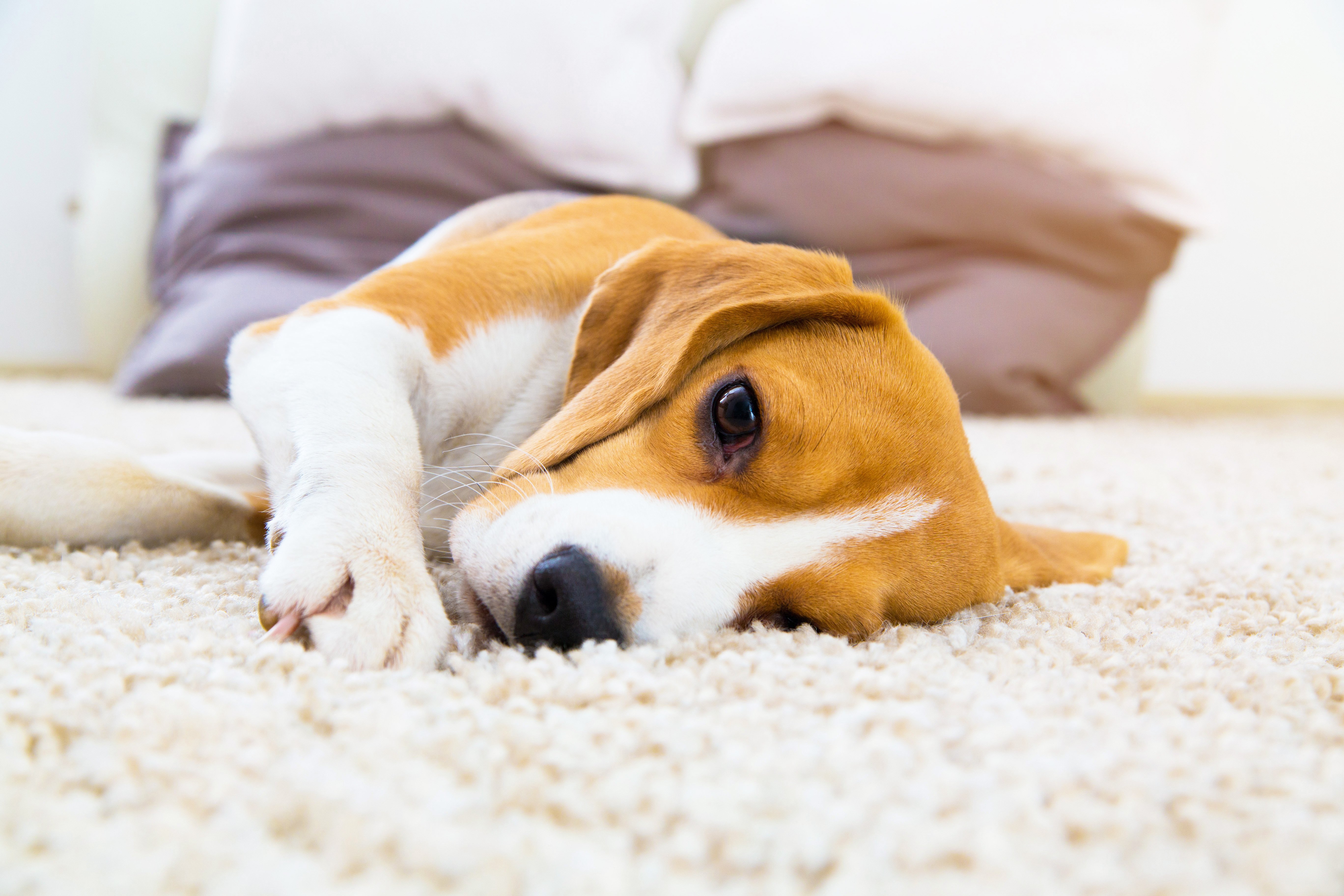
Fear and anxiety are significant conditions affecting the American dog population. In 2011, Thundershirt, the well-known manufacturer of the eponymous anxiety-reducing wearable product, had an independent survey company conduct two separate surveys about anxiety in dogs.
According to the surveys, 30% of dogs suffered from some type of anxiety, with 16% suffering from more than one. Noise, separation, and fear anxiety were the most common types.
In this article, we’re going to review these common types of anxiety, conditions in which they can occur, along with treatment and prevention tips. I encourage you to really read through the points of this article. There are many pups out there that need these issues addressed and there are many pet parents out there who simply don’t realize what to look for or where to start.
Separation Anxiety
Statistically the most common form of anxiety, affecting anywhere from 10% up to 40% of our dog population, depending on sources.
Separation anxiety in dogs stems from fear of being alone. Most often, we see this first present gradually in a growing puppy, or it might be perceived to occur “suddenly” in a newly adopted pooch.
Separation anxiety can take many forms, but often presents as destructive behavior. You might see clothes chewed up, the trash can upended, toilet paper shredded, doors scratched or chewed. We can also see pups poop and pee in the house, and noise complaints from neighbors because of a dog’s excessive barking and howling all day long when his human companions are not home.
Separation anxiety in dogs is so common, that there are several products, including medications, labeled specifically for it.
Fear Anxiety
Fear anxiety is challenging because of the need to figure out a pattern of what a pup is fearful of. Sometimes, it’s easy, because you see the behavior only in a very specific situation, like at the vet office or groomer.
But fear can take many forms. There can be fear of strangers, other dogs or animals, certain locations (other than my veterinary office), or even certain objects.
I encountered a dog once who was terribly afraid of running water. This included faucets, the hose, rain, and streams. It just shows that fear anxiety can include just about anything.
Now one big misconception people have about fear is the assumption of abuse always being a part of the equation. You might suspect for example, that the dog I saw who was afraid of running water was probably sprayed with a hose as punishment. Abuse is certainly very serious and can definitely be an unfortunate part of a pet’s history.
However, I find that abuse generally is less common compared to a dog having a lack of familiarity and exposure to that which she is afraid of.
For example, if you take a dog who spent most of his life in Arizona, then move him to Vermont, he might be so scared of snow and ice, he’ll refuse to go outside simply because he doesn’t understand what it is. It’s a simple example, but can apply to many situations. Some dogs afraid of people or other dogs were simply never socialized well as puppies during their crucial period of development.
Early training and prevention is the best method to avoid fear anxieties, which we’ll get to in a minute, along with some tips if your adult pup already experiences a fear anxiety.
Noise Anxiety
Noise anxiety kind of partners with fear, because it is a fear of something. However, it just about deserves its own category because there are many dogs who do just fine in many situations. But when summer thunderstorms hit, or if you break out the fireworks on the Fourth of July or try to have your kitchen remodeled, your pup is hiding under the bed to avoid the crashes, booms, hammer falls, and whines of a high-speed drill.
Noise anxiety is such a concern that various products, including medications, are specifically labeled for it, just as with separation anxiety.
So now that we know a little more about a couple types of anxiety, what can we do about them?

Getting a General Idea of the Situation
Before we get to management and prevention tips, I find it helpful to divide anxiety that an individual dog is experiencing into situational or generalized.
Situational anxiety is just that. There are only particular situations where a pup experiences anxiety. This might be only separation anxiety, or only severe noise sensitivity. With fear anxiety, a dog may have only one situation that generates a fear response, or there could be two or three triggers.
Generalized anxiety involves multiple triggers. Typically so many that it’s hard to make out any situations where a dog is not anxious or fearful. In humans, generalized anxiety disorder (GAD) is referred to as excessive anxiety occurring more days than not for a period of at least six months relating to a number of events or activities where the degree of fear is disproportionate to the actual likelihood of the feared event.
According to a 2009 Compendium article on the topic, veterinary behaviorist Dr. Sharon Crowell-Davis indicates that pet patients may exhibit signs very similar to humans with GAD. More specifically, a pet shows constant signs of fear and anxiety, regardless of the situation or exposure.
Dr. Crowell-Davis mentions that many newly adopted pets can exhibit some signs of low-level anxiety when entering a new home. However, if a period of 2-3 months passes and the pet’s anxieties persist, a generalized anxiety disorder can be presumed.
Treatment
And now, we arrive at some strategies for managing certain anxiety and fear behaviors. Ways of addressing fear and anxiety in dogs can be divided into behavior modification, supplements, and medication therapy.
Behavior Modification
Behavior modification is a core component of addressing any anxiety or fear condition. By modifying a behavior that is related to fear, it can be possible in some cases to avoid the need for medical therapy. Although in many cases our goal is to simply reduce the need as much as possible without the expectation of eliminating it.
There are three types of behavior modification applied in treating fear and anxiety.
Counterconditioning
Counterconditioning is a strategy whereby we aim to change a dog’s emotional response to a particular stimulus. A simple example is when a delivery person comes to the door, and your dog, very anxious about strangers approaching his home, barks incessantly or even growls at the door.
We would look to pair the sight, smell, and sound of an approaching delivery person with a positive reward to alter the dog’s state from fear and anxiety to one that is positive. It is also crucial to avoid any negative outcomes during counterconditioning training. A simple way to accomplish this is to initiate a command, like “sit” or “stay” to redirect your pup’s focus away from the stimulus. Then, with his attention on you, you can provide treat rewards until the stimulus passes (in other words, the delivery person drops off their package and is walking back to their truck.
A real world example of this involves one of my staff members’ pups, who I will call Rosa. Rosa is an extremely sweet dog, but has a particular anxiety directed towards delivery men, especially if they wear hats. Rosa was adopted by our staff member after one year of age and thus the origin of her anxiety is unknown.
At our hospital, the same guys tend to deliver packages, whether from UPS or FedEx, and they all came to know Rosa. Early in the morning, before appointments really starting filling in, Rosa would be free to roam the treatment area, though she would most often sit near our chairs. But if a delivery guy came in to drop off a package, she would be immediately up and barking at his heels. Although her behavior never escalated to more than barking, her behavior understandably made many of our delivery guys nervous.
We started by training Rosa to sit and focus whenever the delivery guy would come in. It was a little challenging at first to keep her focus, but she was already an otherwise friendly and obedient little dog, and treats are hard to ignore.
We’d give her a small training treat to help keep her attention until the delivery guy left. Eventually, as they began to appreciate our efforts and see improvement in her behavior, a couple of the regular delivery guys would even participate, giving her a command to sit, and then feeding her a treat.
Over a couple of weeks, with all staff members participating (and some of the delivery guys too!), Rosa became far less anxious about deliveries, and we even reached a point where we rarely needed to provide any special commands or treats.
Desensitization
Desensitization involves gradual exposure to situations or stimuli by finding that threshold below which a pup doesn’t exhibit a fear or anxiety response.
Take the pup afraid of running water for example. This pup would have a clear fear of any large amounts of running water, like a stream or river, so we know we need to start lower. But as I mentioned, even a running faucet exhibited a fear response, so we know we have to go even lower than that.
Thus, we might find that a trickling faucet would be acceptable. By redirecting attention in the presence of the stimulus, and providing treat rewards, we could gradually increase the amount of running water in the sink and desensitize that pup.
This could also be applied to noise sensitivity too. Perhaps there’s a particular item or tool in the home that needs to be used on a regular basis, like a blender. The high setting on a blender may elicit a fear response, but we might find that the lowest setting does not. We could theoretically keep the pup in the kitchen, providing a treat or other distraction and over the course of a couple weeks, gradually increase the blender speeds.
The trick of course with desensitization, as with counterconditioning, is that there cannot be any negative outcomes. Thus, if a family member unfamiliar with the training efforts comes down to make a smoothie and sets the blender on high, your pup may be terrified to even enter the kitchen and you’ll have to start over again. This also highlights the importance of any family members, housemates, or other stakeholders all being an active part of training.

Situation Avoidance
Situation avoidance is not always possible, but if it is, this strategy can go a long way towards outright eliminating situational anxiety or fear.
A very simple example could be a dog who is afraid of horses. You’re not around horses regularly, so maybe you discovered this when you took the family to a friend’s farm, or by running into a small cavalcade at a state park. Whatever the reason, you don’t have the need to be around horses with your dog on a regular basis, and so without the need for further training or therapy, you can simply avoid being around horses with your pooch.
Another example that may be more common is fear or aggression towards other dogs. I see signs of this quite often when out on jogs through the neighborhood. While it’s not practical to remove outdoor walks from your dog’s schedule, there are ways to avoid situations that would induce a fear or aggression response towards another dog.
For one thing, you would need to avoid dog parks, and taking your pup to the pet store or a dog-friendly hardware store would be out as well. When on walks outside though, you can choose a route that is open and where you can see any other pup/pup parent pairs approaching.
If you do see another dog approaching on a leash with his human companion, take the initiative to cross to the opposite side of the street where they may only be able to see each other at a far distance. You can then employ counterconditioning (or desensitization if you find that no fear/aggression response occurs at a certain distance) until the other dog passes by.
Supplements
There are many products in the supplement category that can be used to address anxiety. The benefit for considering them first, along with behavior modification, is that there is a very low risk of adverse effects, while they can bolster your efforts with training.
Melatonin, as found in Calm Down, is a naturally occurring hormone that helps to regulate the sleep cycle. It can also naturally help with anxiety and stress by promoting a calming and relaxing effect. Many humans take melatonin supplements to help them sleep, or to just relax. Melatonin may be of the best benefit to some of our older pups suffering from cognitive dysfunction and associated anxiety, especially at night.
L-tryptophan, also found in Calm Down, is an essential amino acid that acts as a precursor to serotonin, a major neurotransmitter in our bodies (and our pups’ bodies too!) that influences mood and sleep. Many humans with depression have been found to have low circulating levels of L-tryptophan. Supplementing it in theory can help boost serotonin levels, improving mood and the sleep cycle.
L-theanine is another amino acid but is not an essential one and is not produced by our bodies. It is found naturally in green and black teas. However, since it may have the ability to influence certain chemicals in the brain like serotonin and dopamine that influence mood, sleep, and stress, it can be very beneficial for anxious dogs. There have been a couple studies in people that have demonstrated a clear benefit for l-theanine and anecdotally, I have seen a number of dogs respond quite well to it.
Hydrolyzed bovine (cow) milk protein may seem like an odd item to help relieve anxiety, but it has shown to generate positive effects on stress and anxiety by inducing a calming effect. There are many veterinary behaviorists that utilize hydrolyzed milk protein in their protocols, as it certainly appears to have benefit and does not interact with any medications being prescribed. It can also be used for a couple days in advance to a particular known upcoming stressor (like a visit to the vet or the Fourth of July) or can be given on a daily basis.
There is a lot of research in the works for the benefits of hemp and hemp-derivative products for pets. Industrial hemp contains low levels of cannabinoids that bind to very specific receptors in the body and can modulate a variety of conditions, including anxiety and stress. Hemp seed oil and hemp seed powder, as found in Hemp Calm Down, are natural hemp plant extracts and exhibit little to no adverse effects when included in reputable products.
It should be clearly noted that hemp extracts are not synonymous with purified cannabidiol (CBD) products nor are they the same thing as marijuana, which is a completely different cultivar of plant from hemp. The THC in marijuana can actually induce fear, paranoia, and toxicity signs in pets, and marijuana should never be given to a pet for any reason. But because there is a lot of confusion and blurred lines about hemp vs. marijuana, make sure to carefully review any product labels, product standards, and claims and discuss any products you’re considering with your veterinarian.
Medication
If starting off with a supplement and behavioral modification is not bringing about a desired outcome in reducing a pup’s fear and anxiety, or in cases where a pup’s anxiety is generalized and severe, we then sometimes turn to prescription medications.
Prescription medications for treating anxiety act on neurotransmitters in the brain, like serotonin or dopamine, and try to bring them into better balance. As we’ve discussed, some short-term medications may be indicated for situational anxiety, like alprazolam or trazodone. Others, like clomipramine and fluoxetine, are designed more for long-term therapy, as with generalized anxiety disorders.
The downside to medications used for anxiety, like selective serotonin reuptake inhibitors (SSRIs) and tricyclic antidepressants, is that they can have unintended effects. While some dogs seem to tolerate medical therapy perfectly well, others may experience excessive sedation and lethargy. In still other patients we may see just the opposite of what we want, including worsened anxiety and fear, and sometimes aggression.
This is why it’s extremely important to discuss with your veterinarian any possible need your pup might have for medical therapy for anxiety, fear, or stress. As mentioned, sometimes there are alternatives to medical therapy that can be pursued first. It’s also paramount to include behavior modification in conjunction with any medical therapy, because it is possible in some cases to wean a dog off of medication with the right level of consistent training.
Prevention
Well, we’ve thoroughly discussed treating stress, fear, and anxiety in dogs but what about keeping it from happening in the first place?
Unfortunately, sometimes you can’t. As with the example of the dog living in Arizona who is terrified of snow and ice when his family moves to Vermont, you can’t expose a pup to every conceivable fear trigger out there. We also have to remember that anxiety in dogs can be inherited genetically, as with humans, and some dogs may be predisposed from birth.
But in many cases, anxieties can be prevented through appropriate training and conditioning at a young age. This is especially true of separation anxiety, fear of other people or animals, and fear of certain common places.
Crate Training
Crate training is an extremely important part of training a puppy and helps on a number of points. Fully discussing crate training is beyond the scope of this article, but the American Kennel Club has several good articles that go into more detail about how to properly crate train.
One of the biggest mistakes pet owners do make about use of a crate is to turn it into a form of punishment, as well as a place to cage up a dog when the family is gone. The pooch then associates the crate with negative experiences, and this defeats the whole purpose of crate training in the first place.
A crate should be a safe space for a pup, with durable, safe toys, and sometimes food and water (at least during initial training). He should be allowed to come and go from the crate as he wishes when the family is home. It can also be important to close the crate for designated rest time, even when folks are home, as this can help a dog avoid associating the crate with being alone.
When you do have to leave the house, it can help to have a pup go to his crate for some preset period before you actually walk out the door. A strategy to work on separation anxiety is to start crating the anxious pup, say, one hour prior to departure, and gradually reduce this time over a couple of weeks, until you can have him head to his crate just a couple minutes prior to you leaving without any issue.
Socialization
Dogs, just like people, need to learn from a very young age what behavior is appropriate in certain situations and with certain other entities, be them people or other animals.
The age from weaning up to about 6 months is a crucial time in a puppy’s development to be exposed to anything we want her to be comfortable around as an adult. She also has to learn the most appropriate way to act. This is why learning some behaviors from an older mentor dog is extremely important.
One-on-one time with an older, calm, and well-trained dog goes far. A nippy and jumpy puppy will very quickly be told to mind his manners in a way only another dog can accomplish. The puppy will quickly learn to emulate the older dog’s behaviors (again, why we want a calm and well-trained dog), much like a padawan to a Jedi master. If you don’t have an older dog in the home, consider some dates with a friend or family member’s pup. If you need to work on commands, leash training, etc., consider an in-home trainer who will work with you and your pup on an individual basis.
For further socialization, think about what scenarios you’ll want your pup to be in when he grows up and work on those at an early age. If you want him to be around horses everyday, don’t wait until he’s 8 months old to see a horse for the first time.
If you want him to be comfortable around other dogs, make sure to make additional dates with other trusted friends’ or family members’ dogs so he can get used to different canine personalities. The same goes with people. Above all, make sure these experiences are as positive as possible.
Why Punishment doesn’t work
I still see punishment methods used far too often with young dogs. It is our tendency as humans to err more on the side of correction for something done incorrectly vs. a reward for a job well done.
And initially, some people who believe in punishment as part of training may see a perceived benefit. Punishment may suppress the behavior, this is true. But it also concurrently increases a dog’s fear or anxiety about the particular situation, gradually making their fear response worse over time. Punishment also doesn’t teach or train a pup to do anything other than to be further fearful, and thus no long-term benefit or change ever occurs.
I have seen this in my own veterinary office, where an owner may use physical force simply because his pup won’t sit still on the table. I know this isn’t only happening at my office, and as a result I’ve seen a perfectly happy and playful 12 week old puppy cowering and growling at me a year later. Now the pup is no longer amenable to any kind of even low-stress handling. And yet, his fear response is further met with physical force from his owner for not cooperating.
For this reason, I do not allow any kind of physical force correction like this to be employed during my appointments. Unfortunately, many dog owners who “know better” continue it in other situations, bolstering their dog’s fear and aggression responses.
This is why in today’s age of training, most dog trainers are no longer advocates of shock collars or similar devices that induce a punishment for an unwanted behavior, like barking.
Dogs do also have the ability to be so fearful or reactive to a stimulus, that this overcomes any fear of the punishment tool, and serious injury can then result.
I saw a dog once for burns on his neck induced by a “no-bark” shock collar. The owners had started using one because the little dog would bark non-stop with guests in the house.
The owners had never meant to intentionally bring harm to their pup, and felt so awful when they brought him in to be treated, that they left the shock collar with me. I threw it away and gave them a business card for the excellent in-home training group that we utilize.

With Great Anxiety Comes Great Responsibility
Managing a fearful or anxious dog is a big responsibility. If you have recently adopted a dog that already has these behaviors, you have to first realize and take charge of that responsibility. Second, you have to realize that working to change these behaviors takes time.
If you have a new puppy, start with socializing and establishing good behaviors now. Don’t wait. If you’re concerned about a particular behavior and your dog is already 5 or 6 months old, seek help.
First, start by speaking with your veterinarian. Some behaviors and training questions may be more simple to discuss and come up with solutions for than you may realize. Your veterinarian is also going to be the best source to provide you with a list of trainers in the area. In-home trainers that incorporate you deeply in your dog’s training are the best.
Your veterinarian will also be the best source to discuss supplements that may be of benefit, as well as to discuss if medication is a consideration or not. In some cases, your veterinarian may refer you to a board-certified veterinary behaviorist. A veterinary behaviorist is a specialist veterinarian who has completed a residency program in behavior, and after studying under other behaviorists, has passed a qualifying board examination.
Remember that anxiety, fear, and stress, while we don’t always think of them as illnesses, can truly be just that. For humans and for pets, anxiety, fear, and stress can truly alter quality of life and negatively impact the human animal bond. If you think your dog is suffering from a behavioral disorder, treat it like you would any physical illness, and touch base with your veterinarian today.
3 Comments
About Us
We've taken the guesswork out of caring for your pets. Our formulations are created by experienced veterinarians to address specific solutions for a variety of pet issues.
All of our products are:
As seen on:












Very informative post
Hi there! I’m wondering if you offer help with adult/senior dogs, I have a 7 year old chihuahua who I rescued, his anxiety is just breaking my heart and I dont know where to turn
Our Calm Down Calming Aid is a great way to help your pup with anxiety! To learn more https://healthysolutionsforpets.com/shop/?yith_wcan=1&product_animal_types=dog&product_cat=calming-dog-supplements.